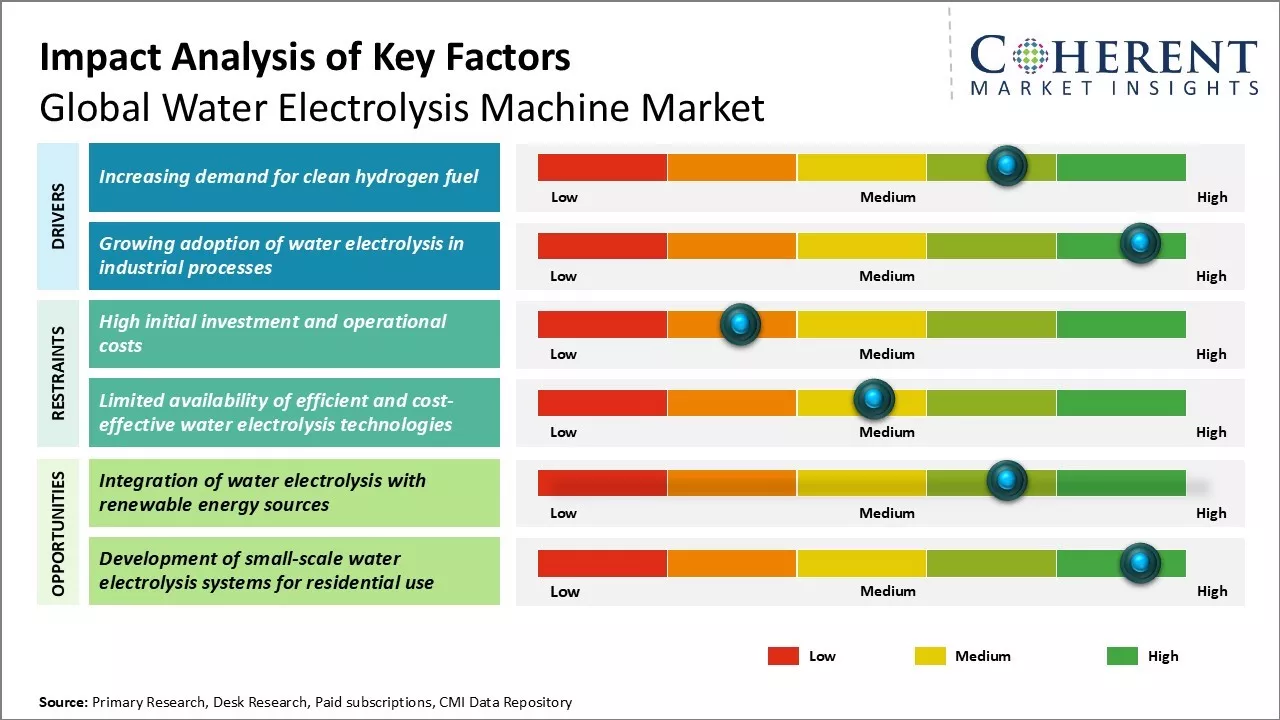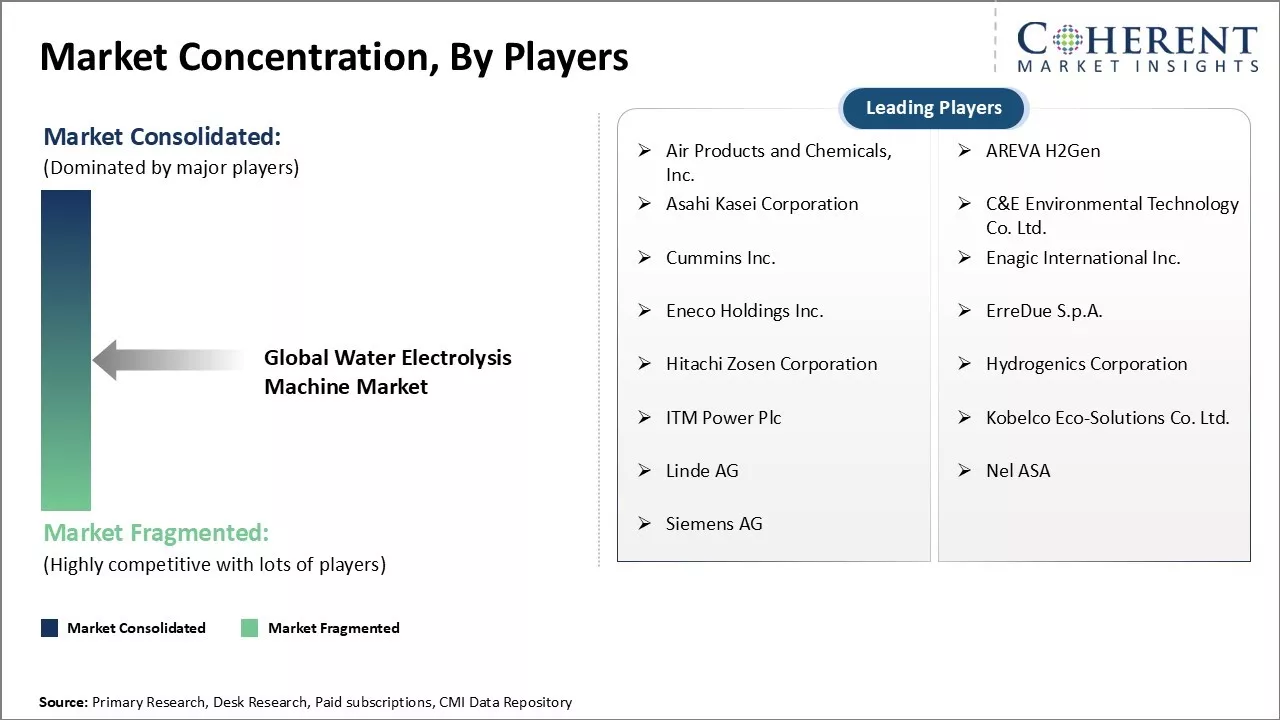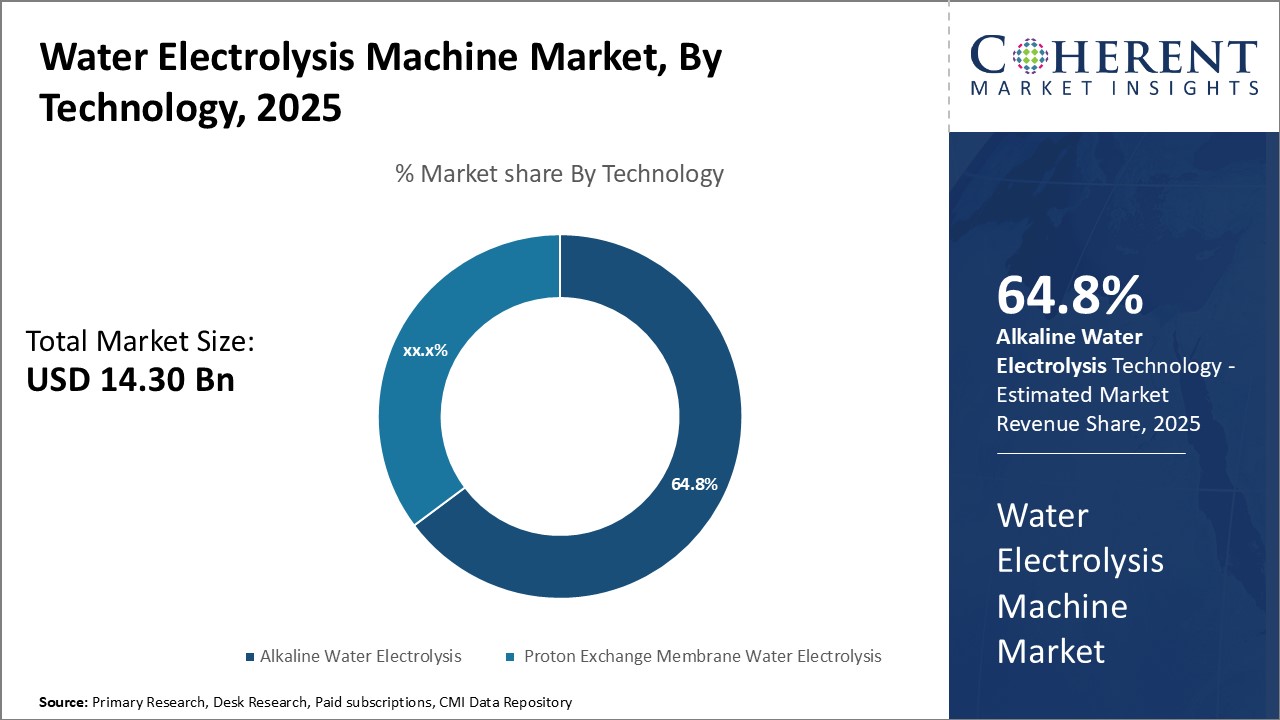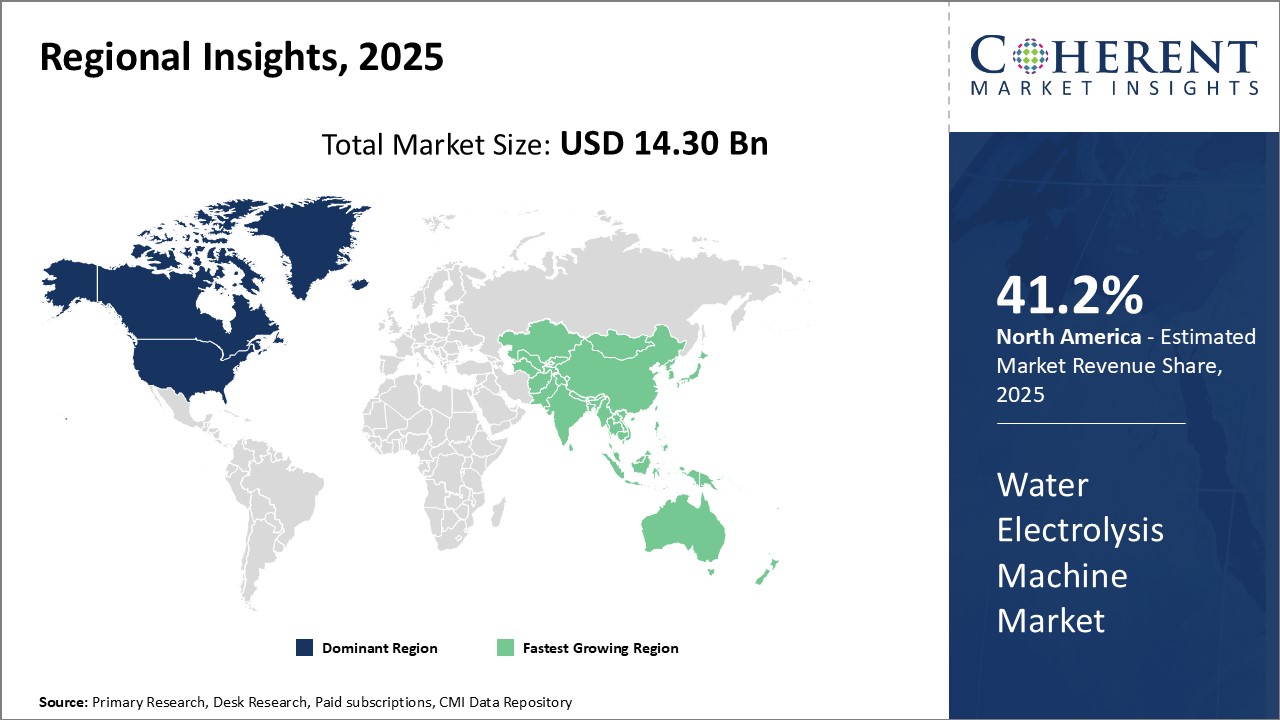Water Electrolysis Machine Market Size and Trends
The global water electrolysis machine market is estimated to be valued at US$ 14.30 Bn in 2025 and is expected to reach US$ 24.52 Bn by 2032, exhibiting a compound annual growth rate (CAGR) of 8.0% from 2025 to 2032.

Discover market dynamics shaping the industry: Download Free Sample
The water electrolysis machine market is driven by factors such as increasing focus on developing renewable and green hydrogen, initiatives towards developing hydrogen economy by many countries, and rising demand for hydrogen fuel cell vehicles. Government incentives and policies promoting the use of clean energy are also creating opportunities for electrolysis machine manufacturers. However, high installation costs of electrolysis equipment remain a challenge for widespread adoption. Key players in the market are investing in lowering the costs through technological advancements and economies of scale.
Increasing demand for clean hydrogen fuel
The global push towards clean and renewable energy sources has boosted interest in hydrogen fuel. Many governments and companies see hydrogen as integral to achieving carbon neutrality goals over the coming decades. Hydrogen can be produced through water electrolysis, which uses renewable electricity to split water into hydrogen and oxygen. The hydrogen produced through this process is considered clean as it does not involve fossil fuels or release greenhouse gases. The end use of clean hydrogen fuel can play a key role in decarbonizing industries and hard to abate sectors like long haul transportation.
Electrolytic hydrogen is gaining significant attention to power fuel cells in vehicles. Major auto manufacturers have unveiled plans for introducing fuel cell electric vehicles that run on hydrogen in the near future. These companies expect hydrogen fuel cell vehicles to provide a viable zero emission alternative to battery electric vehicles for applications requiring long driving ranges like trucks, buses and passenger cars. Furthermore, hydrogen is considered a seasonal energy storage option as it can be produced from surplus renewable power during peaks and be utilized later through fuel cells when renewable sources are intermittent. This is driving research towards establishing necessary hydrogen refueling infrastructure.
Along with transportation, clean hydrogen also has good prospects in energy generation applications. Some remote areas lack access to fossil fuels or natural gas pipelines but have potential for renewable power generation. Electrolytic hydrogen produced from local renewable sources can be used to power micro-grids and energy systems in such off-grid locations through fuel cells or combustion. Overall, the growing worldwide push for carbon neutral economies is creating huge demand for production of clean hydrogen fuel through water electrolysis, favoring widespread adoption of electrolysis technology.
Market Concentration and Competitive Landscape

Get actionable strategies to beat competition: Download Free Sample
Growing Adoption of Water Electrolysis in Industrial Processes
The rapid scale-up of renewable power capacity has led major industries to explore clean hydrogen production through water electrolysis within their operations. Industrial use of hydrogen is well established in oil refining, chemical production and fertilizer manufacturing. Typically, these sectors rely on fossil fuel based methods for hydrogen generation which results in CO2 emissions. Now companies have begun investing in on-site water electrolysis plants to produce emission-free hydrogen using renewable electricity.
For example, some major oil refineries are installing sizable water electrolysis units to generate hydrogen for hydrocracking and other refining processes. This helps cut carbon footprint and also offers marketing advantage of producing cleaner fuels. Similarly, the chemical industry uses large volumes of hydrogen in ammonia synthesis and other production processes. Leading chemical firms have partnered with electrolysis manufacturers to implement utility-scale electrolyzers within chemical plants. Once proven successful, such projects are expected to pave way for even wider electrolytic hydrogen adoption across chemical and refining facilities worldwide.
The metals and materials manufacturing industry is also transitioning towards clean hydrogen. Water electrolysis provides hydrogen feedstock for critical clean technology industries like silicon wafer fabrication. Electrolytic hydrogen production right at industrial sites ensures stable supply and avoids costs associated with gas delivery. Some major manufacturing hubs have stimulated such localized hydrogen generation through policy incentives. Thus, transition to renewable power coupled with growing appreciation of hydrogen's diverse industrial uses is driving robustly growing application of water electrolysis in various manufacturing sectors across regions.
Key Takeaways from Analyst:
The rising demand for green and sustainable hydrogen production is a major driver as it helps reduce carbon emissions. Most large economies are also supporting the production of hydrogen from renewable resources through legislation and investments. This will significantly boost the demand for water electrolysis machines worldwide. Europe currently dominates the market due to favorable government policies around hydrogen economy. However, Asia Pacific is expected to be the fastest growing region with China, Japan, and South Korea ramping up renewable hydrogen production capacity.
While the outlook is positive overall, fluctuating raw material prices remain a challenge for equipment manufacturers. The cost of key components like PEM membranes and rare earth metals required in alkaline electrolyzers are dependent on global supply chains. This can affect the production costs. Finding skilled labor to manufacture and maintain these complex machines is another restraint that OEMs need to address, especially in emerging economies.
The increasing investments in setting up large-scale renewable hydrogen plants presents lucrative opportunities for electrolyzer suppliers. They can partner with such plant developers and utilities to secure long-term contracts. Adopting modular design approaches and advanced manufacturing techniques can help lower costs and improve production capabilities over time.
Market Challenges: High initial investment and operational costs
One of the key challenges for the global water electrolysis machine market is the high initial investment and operational costs associated with these systems. Water electrolysis is a capital-intensive process that requires expensive electrochemical cells, power electronics, and other peripheral equipment. Furthermore, water electrolysis plants need a constant power supply to run, and the electricity consumed accounts for a major portion of the operating expenses. This makes the cost of producing hydrogen through electrolysis substantially higher than through conventional steam methane reforming currently. The high costs have limited the large-scale commercial adoption of water electrolysis especially in developing markets. However, ongoing technology advances and scaling up of manufacturing is helping to reduce capital costs steadily. Still, the high capital expenditure and energy costs pose major barriers for widespread uptake of green hydrogen production through water electrolysis in the near future.
Market Opportunities: Integration with Renewable Energy Sources
The integration of water electrolysis systems with renewable energy sources presents a huge opportunity for the global water electrolysis machine market. As water electrolysis can facilitate energy storage and production of carbon-free hydrogen, it provides a promising solution for the intermittent nature of many renewable power sources. By coupling electrolyzers with solar and wind farms, surplus renewable electricity during times of low demand can be utilized to produce hydrogen through water electrolysis. This hydrogen can then be stored and used later for power generation, heating applications, mobility fuels, and other energy needs. The synergies between water electrolysis and renewables will play a major role in large-scale decarbonization strategies worldwide. Electrolyzer manufacturers are also exploring hybrid water electrolysis-renewable systems, which will further spur adoption across various end-use industries. Over the long term, the increased production and storage of green hydrogen through this integration model is projected to significantly boost demand for water electrolysis machines globally.

Discover high revenue pocket segments and roadmap to it: Download Free Sample
Insights By Technology - Cost Effectiveness Drives Adoption of Alkaline Water Electrolysis
In terms of technology, alkaline water electrolysis segment is expected to contribute 64.8% estimated share of the market owing to its relatively lower capital and operating costs compared to PEM water electrolysis. Alkaline water electrolysis utilizes an alkaline solution, usually potassium hydroxide, as the electrolyte and porous nickel or nickel alloy electrodes. This electrolyte-electrode combination allows alkaline electrolysis systems to operate at lower pressures than PEM systems, reducing mechanical complexity and capital expenditure.
Additionally, alkaline electrolysis systems have longer electrode and membrane lifetimes than PEM systems as the electrolyte is not as corrosive. This leads to lower operating and maintenance costs over time. While PEM technology is more energy efficient at higher current densities, alkaline systems achieve comparable efficiencies at the typical current densities used in large-scale hydrogen production applications. Their simplicity of design also makes alkaline electrolyzers easier to service and maintain compared to more complex PEM stacks.
The lower overall costs of alkaline technology make it particularly attractive for large capacity hydrogen production required for industrial processes and gas-grid injection. Leading end users in chemicals and refining have already deployed multi-megawatt alkaline electrolysis plants to generate hydrogen for their operations. Going forward, the cost competitiveness of alkaline electrolysis will continue boosting its use among industrial enterprises seeking low-cost hydrogen production solutions. While PEM technology progresses, alkaline electrolysis is poised to remain the dominant technology for large-scale hydrogen applications in the near future.
Insights By Application - Power Generation Drives Demand for PEM Water Electrolysis
In terms of application, the hydrogen production segment is expected to contribute the 58.3% share of the market. Within this segment, PEM water electrolysis is increasingly being adopted for power-to-gas and power-to-power applications to help strengthen power grid stability through energy storage. PEM electrolysis systems can rapidly regulate hydrogen production in response to fluctuations in renewable energy output. When solar or wind power generation exceeds electricity demand on the grid, excess power can be used to split water through PEM electrolyzers to produce hydrogen.
This hydrogen can then be stored and transported through existing natural gas infrastructure for re-electrification through fuel cells or combustion turbines during periods of low renewable energy feed-in. This allows electricity generated from intermittent renewable sources to be stored over long durations and released on demand, essentially using hydrogen as a carrier to store excess renewable power. Leading power utilities and gas network operators across regions are testing such power-to-gas solutions using PEM water electrolysis to balance their grids and support higher renewable energy penetrations.
Compared to the slower response times of alkaline electrolysis, PEM technology is particularly suited for power-to-gas applications due to its ability to rapidly regulate hydrogen production rates. PEM electrolyzers' higher current density and energy conversion efficiency also improve the roundtrip efficiency of power-to-gas-to-power energy storage cycles. Their decreasing capital costs will further boost the adoption of PEM electrolysis for promoting renewable energy utilization through power grid balancing applications in the coming years.
Insights By End User - Growth of Clean Energy Drives Industrial Demand for Electrolysis
In terms of end user, industrial segment is expected to contribute the 43% share of the market. The industrial sector encompasses a diverse range of hydrogen consumption including refineries, chemical/petrochemical plants, food processing and others. Currently, the majority of industrial hydrogen is produced through less expensive steam methane reforming. However, regulatory push for clean energy and carbon neutrality is driving increased adoption of water electrolysis in industrial facilities.
Electrolysis allows industrial plants to replace fossil-fuel derived hydrogen with renewable hydrogen over time. Large-scale alkaline and PEM water electrolysis solutions are being set up within industrial premises or nearby to leverage available renewable power and land resources. Manufacturing facilities looking to decarbonize also benefit from the potential to use hydrogen as an alternative fuel in high-temperature furnaces and other industrial heating processes.
The accessibility of hydrogen produced through onsite electrolysis improves hydrogen security and logistics for hydrogen-intensive industries. It eliminates dependency on hydrogen pipelines or liquid hydrogen transports, reducing operational costs. Electrolysis also provides opportunities to leverage existing natural gas infrastructure to store and transport hydrogen generated. As carbon emissions regulations tighten globally, industrial uptake of water electrolysis is expected to rapidly rise this decade to meet clean energy and decarbonization targets for manufacturing operations. Leveraging available renewable energy supplies as well as infrastructure, industries are pioneering the transition to renewable hydrogen using electrolysis.
Regional Insights

Need a Different Region or Segment? Download Free Sample
North America dominates the global water electrolysis machine market with 41.2% in 2025 owing to strong presence of leading manufacturers and favorable government policies encouraging production of green hydrogen. Countries like the U.S and Canada have considerable production facilities of major players like Proton OnSite, Peak Scientific, and Teledyne Energy Systems. Their extensive R&D efforts have resulted in technological advancements making the electrolysis process more efficient and cost effective. Moreover, projects aiming at decarbonization of industries through replacing carbon fuels with hydrogen are receiving sizable funding from governments. This is anticipated to significantly spur domestic demand in the coming years.
The Asia Pacific region is poised to be the fastest growing regional market during the forecast period. Rapid industrialization and urbanization have raised energy demands tremendously. At the same time, concerns over increasing GHG emissions are prompting nations to explore green alternatives. Countries like China, South Korea and Japan are actively supporting hydrogen economy through incentives and large-scale demonstration plants. China has ambitious targets for production capacities and building hydrogen fueling stations. Their focus on renewable energy integration also works in favor of water electrolysis machine market. Major electrolyzer manufacturers from Europe are increasingly setting up manufacturing units in the region to tap vast opportunities.
The European market also stands strong driven by stringent environmental regulations. However, compared to domestic markets, export of water electrolysis machines to Asia Pacific and other regions is growing substantially for European players. This is accredited to their technological superiority and reliability. On the other hand, lack of local manufacturing is causing relatively higher capital costs for Asian customers. But collaborations and technology transfers may help bridge this price gap in the foreseeable future.
Market Report Scope
Water Electrolysis Machine Market Report Coverage
| Report Coverage | Details | ||
|---|---|---|---|
| Base Year: | 2024 | Market Size in 2025: | USD 14.30 Bn |
| Historical Data for: | 2020 To 2024 | Forecast Period: | 2025 To 2032 |
| Forecast Period 2025 to 2032 CAGR: | 8.0% | 2032 Value Projection: | USD 24.52 Bn |
| Geographies covered: |
|
||
| Segments covered: |
|
||
| Companies covered: |
Air Products and Chemicals, Inc., AREVA H2Gen, Asahi Kasei Corporation, C&E Environmental Technology Co. Ltd., Cummins Inc., Enagic International Inc., Eneco Holdings Inc., ErreDue S.p.A., Hitachi Zosen Corporation, Hydrogenics Corporation, ITM Power Plc, Kobelco Eco-Solutions Co. Ltd., Linde AG, Nel ASA, and Siemens AG |
||
| Growth Drivers: |
|
||
| Restraints & Challenges: |
|
||
Uncover macros and micros vetted on 75+ parameters: Get instant access to report
Water Electrolysis Machine Industry News
- In July 2023, ITM Power plc, a leading manufacturer of large-scale electrolysers based on proton exchange membrane (PEM) technology to produce green hydrogen, announced that its newly established subsidiary ITM Power Germany GmbH would formally inaugurate operations in October 2023 in Linden, a town north of Frankfurt. This expansion further strengthens ITM Power's position as a top producer of electrolysers for active projects in Germany and wider Europe today, as well as for future projects currently in the bidding stage.
- In April 2023, Siemens Energy AG, a leading global energy technology company specializing in sustainable energy solutions, announced that production of electrolysis modules (stacks) would commence at its multi-gigawatt electrolyzer facility in Berlin. The facility is set to ramp up to a production capacity of three gigawatts by 2025. Siemens Energy, in collaboration with Air Liquide, a prominent industrial gas supplier, will utilize these stacks to serve a diverse range of clients and meet the rapidly growing demand for green hydrogen solutions.
- In November 2022, Asahi Kasei Corp., a leading Japanese technology company specializing in advanced materials and chemicals, began constructing a pilot test facility for hydrogen generation using alkaline water electrolysis at its Kawasaki Works. To meet the anticipated global demand for hydrogen, Asahi Kasei recognizes the need to significantly scale up electrolysis equipment. As a solution, the company plans to introduce a prototype plant consisting of multiple electrolyzer modules to conduct various trial operations, including testing responsiveness to power fluctuations and assessing long-term durability.
*Definition: The global water electrolysis machine market consists of companies that manufacture and sell machines used for water electrolysis. Water electrolysis machines use electric current to split water into its constituent elements of hydrogen and oxygen. These machines find applications where on-site hydrogen production is required, such as in chemical processing, fuel cells, refineries, food processing, and electronics industries.
Market Segmentation
Technology Insights (Revenue, US$ Bn, 2020 - 2032)
- Alkaline Water Electrolysis
- Proton Exchange Membrane (PEM) Water Electrolysis
Application Insights (Revenue, US$ Bn, 2020 - 2032)
- Hydrogen Production
- Power Generation
- Energy Storage
- Others (Industrial, Research, etc.)
End User Insights (Revenue, US$ Bn, 2020 - 2032)
- Industrial
- Utility
- Commercial
- Others (Residential, Research, etc.)
Regional Insights (Revenue, US$ Bn, 2020 - 2032)
-
- North America
- U.S.
- Canada
- Latin America
- Brazil
- Argentina
- Mexico
- Rest of Latin America
- Europe
- Germany
- U.K.
- Spain
- France
- Italy
- Russia
- Rest of Europe
- Asia Pacific
- China
- India
- Japan
- Australia
- South Korea
- ASEAN
- Rest of Asia Pacific
- Middle East
- GCC Countries
- Israel
- Rest of Middle East
- Africa
- South Africa
- North Africa
- Central Africa
- North America
- Key Players Insights
- Air Products and Chemicals, Inc.
- AREVA H2Gen
- Asahi Kasei Corporation
- C&E Environmental Technology Co. Ltd.
- Cummins Inc.
- Enagic International Inc.
- Eneco Holdings Inc.
- ErreDue S.p.A.
- Hitachi Zosen Corporation
- Hydrogenics Corporation
- ITM Power Plc
- Kobelco Eco-Solutions Co. Ltd.
- Linde AG
- Nel ASA
- Siemens AG
Share
Share
About Author
Ramprasad Bhute is a Senior Research Consultant with over 6 years of experience in market research and business consulting. He manages consulting and market research projects centered on go-to-market strategy, opportunity analysis, competitive landscape, and market size estimation and forecasting. He also advises clients on identifying and targeting absolute opportunities to penetrate untapped markets.
Missing comfort of reading report in your local language? Find your preferred language :
Transform your Strategy with Exclusive Trending Reports :
Frequently Asked Questions
EXISTING CLIENTELE
Joining thousands of companies around the world committed to making the Excellent Business Solutions.
View All Our Clients
